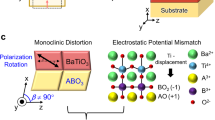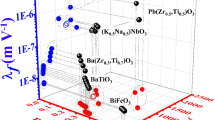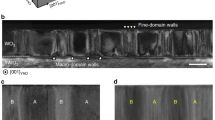Abstract
Piezoelectrics interconvert mechanical energy and electric charge and are widely used in actuators and sensors. The best performing materials are ferroelectrics at a morphotropic phase boundary, where several phases coexist. Switching between these phases by electric field produces a large electromechanical response. In ferroelectric BiFeO3, strain can create a morphotropic-phase-boundary-like phase mixture and thus generate large electric-field-dependent strains. However, this enhanced response occurs at localized, randomly positioned regions of the film. Here, we use epitaxial strain and orientation engineering in tandem—anisotropic epitaxy—to craft a low-symmetry phase of BiFeO3 that acts as a structural bridge between the rhombohedral-like and tetragonal-like polymorphs. Interferometric displacement sensor measurements reveal that this phase has an enhanced piezoelectric coefficient of ×2.4 compared with typical rhombohedral-like BiFeO3. Band-excitation frequency response measurements and first-principles calculations provide evidence that this phase undergoes a transition to the tetragonal-like polymorph under electric field, generating an enhanced piezoelectric response throughout the film and associated field-induced reversible strains. These results offer a route to engineer thin-film piezoelectrics with improved functionalities, with broader perspectives for other functional oxides.
This is a preview of subscription content, access via your institution
Access options
Access Nature and 54 other Nature Portfolio journals
Get Nature+, our best-value online-access subscription
$29.99 / 30 days
cancel any time
Subscribe to this journal
Receive 12 print issues and online access
$259.00 per year
only $21.58 per issue
Buy this article
- Purchase on Springer Link
- Instant access to full article PDF
Prices may be subject to local taxes which are calculated during checkout




Similar content being viewed by others
Data availability
The data that support the findings of this study are available from the corresponding authors upon request.
References
Fu, H. & Cohen, R. E. Polarization rotation mechanism for ultrahigh electromechanical response in single-crystal piezoelectrics. Nature 403, 281–283 (2000).
Zhang, S. et al. Advantages and challenges of relaxor-PbTiO3 ferroelectric crystals for electroacoustic transducers – a review. Prog. Mater. Sci. 68, 1–66 (2015).
Damjanovic, D. Contributions to the piezoelectric effect in ferroelectric single crystals and ceramics. J. Am. Ceram. Soc. 88, 2663–2676 (2005).
Ahart, M. et al. Origin of morphotropic phase boundaries in ferroelectrics. Nature 451, 545–548 (2008).
Cross, E. Lead-free at last. Nature 432, 24–25 (2004).
Jaffe, B. Piezoelectric Ceramics (Academic Press, 1971).
Li, F. et al. The origin of ultrahigh piezoelectricity in relaxor-ferroelectric solid solution crystals. Nat. Commun. 7, 13807 (2016).
Liu, W. & Ren, X. Large piezoelectric effect in Pb-free ceramics. Phys. Rev. Lett. 103, 257602 (2009).
Noheda, B. et al. Polarization rotation via a monoclinic phase in the piezoelectric 92% PbZn1/3Nb2/3O3-8% PbTiO3. Phys. Rev. Lett. 86, 3891–3894 (2001).
Saito, Y. et al. Lead-free piezoceramics. Nature 432, 84–87 (2004).
Schönau, K. A. et al. Nanodomain structure of Pb[Zr1−xTix]O3 at its morphotropic phase boundary: investigations from local to average structure. Phys. Rev. B 75, 184117 (2007).
Zeches, R. J. et al. A strain-driven morphotropic phase boundary in BiFeO3. Science 326, 977–980 (2009).
Jin, Y. M., Wang, Y. U., Khachaturyan, A. G., Li, J. F. & Viehland, D. Conformal miniaturization of domains with low domain-wall energy: monoclinic ferroelectric states near the morphotropic phase boundaries. Phys. Rev. Lett. 91, 197601 (2003).
Noheda, B. et al. A monoclinic ferroelectric phase in the Pb(Zr1–xTix)O3 solid solution. Appl. Phys. Lett. 74, 2059–2061 (1999).
Sando, D., Xu, B., Bellaiche, L. & Nagarajan, V. A multiferroic on the brink: uncovering the nuances of strain-induced transitions in BiFeO3. Appl. Phys. Rev. 3, 011106 (2016).
Sando, D. et al. Large elasto-optic effect and reversible electrochromism in multiferroic BiFeO3. Nat. Commun. 7, 10718 (2016).
Sando, D. et al. Crafting the magnonic and spintronic response of BiFeO3 films by epitaxial strain. Nat. Mater. 12, 641–646 (2013).
Béa, H. et al. Evidence for room-temperature multiferroicity in a compound with a giant axial ratio. Phys. Rev. Lett. 102, 217603 (2009).
Damodaran, A. R., Lee, S., Karthik, J., MacLaren, S. & Martin, L. W. Temperature and thickness evolution and epitaxial breakdown in highly strained BiFeO3 thin films. Phys. Rev. B 85, 024113 (2012).
Noheda, B. et al. Stability of the monoclinic phase in the ferroelectric perovskite PbZr1–xTixO3. Phys. Rev. B 63, 014103 (2000).
Heo, Y., Jang, B.-K., Kim, S. J., Yang, C.-H. & Seidel, J. Nanoscale mechanical softening of morphotropic BiFeO3. Adv. Mater. 26, 7568–7572 (2014).
Chen, Z. et al. Coexistence of ferroelectric triclinic phases in highly strained BiFeO3 films. Phys. Rev. B 84, 094116 (2011).
Bellaiche, L., García, A. & Vanderbilt, D. Finite-temperature properties of PbZr1–xTixO3 alloys from first principles. Phys. Rev. Lett. 84, 5427–5430 (2000).
Lisenkov, S., Rahmedov, D. & Bellaiche, L. Electric-field-induced paths in multiferroic BiFeO3 from atomistic simulations. Phys. Rev. Lett. 103, 047204 (2009).
Davis, M., Budimir, M., Damjanovic, D. & Setter, N. Rotator and extender ferroelectrics: importance of the shear coefficient to the piezoelectric properties of domain-engineered crystals and ceramics. J. Appl. Phys. 101, 054112 (2007).
Damodaran, A. R. et al. Nanoscale structure and mechanism for enhanced electromechanical response of highly strained BiFeO3 thin films. Adv. Mater. 23, 3170–3175 (2011).
Zhang, J. X. et al. Large field-induced strains in a lead-free piezoelectric material. Nat. Nanotechnol. 6, 98–102 (2011).
Zhang, J. et al. A nanoscale shape memory oxide. Nat. Commun. 4, 2768 (2013).
Li, F. et al. Giant piezoelectricity of Sm-doped Pb(Mg1/3Nb2/3)O3-PbTiO3 single crystals. Science 364, 264–268 (2019).
Ren, X. Large electric-field-induced strain in ferroelectric crystals by point-defect-mediated reversible domain switching. Nat. Mater. 3, 91–94 (2004).
Sinsheimer, J. et al. Engineering polarization rotation in a ferroelectric superlattice. Phys. Rev. Lett. 109, 167601 (2012).
Schlom, D. G. et al. Strain tuning of ferroelectric thin films. Annu. Rev. Mater. Res. 37, 589–626 (2007).
Gui, Z. & Bellaiche, L. Tuning and optimizing properties of ferroelectric films grown on a single substrate: a first-principles-based study. Phys. Rev. B 91, 020102 (2015).
Xu, R. et al. Ferroelectric polarization reversal via successive ferroelastic transitions. Nat. Mater. 14, 79–86 (2015).
Yan, L., Cao, H., Li, J. & Viehland, D. Triclinic phase in tilted (001) oriented BiFeO3 epitaxial thin films. Appl. Phys. Lett. 94, 132901 (2009).
Jang, H. W. et al. Strain-induced polarization rotation in epitaxial (001) BiFeO3 thin films. Phys. Rev. Lett. 101, 107602 (2008).
Hÿtch, M. J., Snoeck, E. & Kilaas, R. Quantitative measurement of displacement and strain fields from HREM micrographs. Ultramicroscopy 74, 131–146 (1998).
Baek, S. H. et al. Ferroelastic switching for nanoscale non-volatile magnetoelectric devices. Nat. Mater. 9, 309–314 (2010).
Liu, G. et al. Positive effect of an internal depolarization field in ultrathin epitaxial ferroelectric films. Adv. Electron. Mater. 2, 1500288 (2016).
Labuda, A. & Proksch, R. Quantitative measurements of electromechanical response with a combined optical beam and interferometric atomic force microscope. Appl. Phys. Lett. 106, 253103 (2015).
Jesse, S. & Kalinin, S. V. Band excitation in scanning probe microscopy: sines of change. J. Phys. D 44, 464006 (2011).
Li, Q. et al. Giant elastic tunability in strained BiFeO3 near an electrically induced phase transition. Nat. Commun. 6, 8985 (2015).
Li, Q. et al. Probing local bias-induced transitions using photothermal excitation contact resonance atomic force microscopy and voltage spectroscopy. ACS Nano 9, 1848–1857 (2015).
Kresse, G. & Joubert, D. From ultrasoft pseudopotentials to the projector augmented-wave method. Phys. Rev. B 59, 1758–1775 (1999).
Kornev, I. A., Lisenkov, S., Haumont, R., Dkhil, B. & Bellaiche, L. Finite-temperature properties of multiferroic BiFeO3. Phys. Rev. Lett. 99, 227602 (2007).
Daumont, C. et al. Strain dependence of polarization and piezoelectric response in epitaxial BiFeO3 thin films. J. Phys. Condens. Matter 24, 162202 (2012).
Shang, S. L., Sheng, G., Wang, Y., Chen, L. Q. & Liu, Z. K. Elastic properties of cubic and rhombohedral BiFeO3 from first-principles calculations. Phys. Rev. B 80, 052102 (2009).
Singh, A. K. et al. Origin of high piezoelectric response of Pb(ZrxTi1−x)O3 at the morphotropic phase boundary: role of elastic instability. Appl. Phys. Lett. 92, 022910 (2008).
Carpenter, M. A. & Salje, E. K. H. Elastic anomalies in minerals due to structural phase transitions. Eur. J. Mineral. 10, 693–812 (1998).
Rossetti, G. A., Khachaturyan, A. G., Akcay, G. & Ni, Y. Ferroelectric solid solutions with morphotropic boundaries: vanishing polarization anisotropy, adaptive, polar glass, and two-phase states. J. Appl. Phys. 103, 114113 (2008).
Borisevich, A. Y. et al. Atomic-scale evolution of modulated phases at the ferroelectric–antiferroelectric morphotropic phase boundary controlled by flexoelectric interaction. Nat. Commun. 3, 775 (2012).
Sando, D. et al. Linear electro-optic effect in multiferroic BiFeO3 thin films. Phys. Rev. B 89, 195106 (2014).
Eltes, F. et al. An integrated optical modulator operating at cryogenic temperatures. Nat. Mater. 19, 1164–1168 (2020).
Perdew, J. P. et al. Restoring the density-gradient expansion for exchange in solids and surfaces. Phys. Rev. Lett. 100, 136406 (2008).
Xu, C., Xu, B., Dupé, B. & Bellaiche, L. Magnetic interactions in BiFeO3: a first-principles study. Phys. Rev. B 99, 104420 (2019).
Wojdel, J. C. & Íñiguez, J. Ab initio indications for giant magnetoelectric effects driven by structural softness. Phys. Rev. Lett. 105, 037208 (2010).
Prosandeev, S., Wang, D., Ren, W., Íñiguez, J. & Bellaiche, L. Novel nanoscale twinned phases in perovskite oxides. Adv. Funct. Mater. 23, 234–240 (2013).
Fu, H. & Bellaiche, L. First-principles determination of electromechanical responses of solids under finite electric fields. Phys. Rev. Lett. 91, 057601 (2003).
Xu, C. et al. Electric-field switching of magnetic topological charge in type-I multiferroics. Phys. Rev. Lett. 125, 037203 (2020).
Chaput, L., Togo, A., Tanaka, I. & Hug, G. Phonon-phonon interactions in transition metals. Phys. Rev. B 84, 094302 (2011).
King-Smith, R. D. & Vanderbilt, D. Theory of polarization of crystalline solids. Phys. Rev. B 47, 1651–1654 (1993).
Acknowledgements
This research was partially supported by the Australian Research Council (ARC) Centre of Excellence in Future Low-Energy Electronics Technologies (project no. CE170100039) and funded by the Australian Government. D.S. and V.N. acknowledge the support of the ARC through Discovery grants. O.P. acknowledges the Australian Government Research Training Program Scholarship, the Australian Institute for Nuclear Science and Engineering (AINSE) post-graduate research award and the Scholarship AINSE Australian Nuclear Science and Technology Organisation (ANSTO) French Embassy programme. C.X. and L.B. acknowledge the Defense Advanced Research Projects Agency (DARPA) grant no. HR0011727183-D18AP00010 (Topological Excitations in Electronics (TEE) Program) and the Vannevar Bush Faculty Fellowship grant no. N00014-20-1-2834 from the US Department of Defense. X.C. acknowledges the use of facilities within the Monash Centre for Electron Microscopy, which were funded by ARC grants ARC Funding (LE0454166) and ARC Funding (LE0882821). The piezoresponse spectroscopy measurements were supported by the US Department of Energy, Office of Science, Basic Energy Sciences, Materials Sciences and Engineering Division (K.P.K.) and performed at Oak Ridge National Laboratory’s Center for Nanophase Materials Sciences, which also provided support (R.K.V.), and is a US Department of Energy Office of Science User Facility. B.X. thanks the National Natural Science Foundation of China for financial support under grant no. 12074277 and the Natural Science Foundation of Jiangsu Province (BK20201404). We thank C. Paillard for fruitful discussions and for sharing his scripts, and L. Collins for assistance with the IDS measurements.
Author information
Authors and Affiliations
Contributions
D.S. and V.N. conceived and supervised the study. O.P. and D.S. fabricated the films and performed X-ray diffraction experiments and analysis. X.C., Y.Z. and A.d.M. carried out STEM and geometric phase analysis. R.K.V. and K.P.K. performed the BEPS and IDS measurements and analysed the data. C.X. performed DFT calculations and B.X. carried out effective Hamiltonian simulations under the supervision of L.B.; O.P., D.S. and V.N. wrote the manuscript. All authors contributed to data analysis and manuscript preparation and commented on the manuscript.
Corresponding authors
Ethics declarations
Competing interests
The authors declare no competing interests.
Additional information
Peer review information Nature Materials thanks Kathrin Dörr, Sverre Selbach and the other, anonymous, reviewer(s) for their contribution to the peer review of this work.
Publisher’s note Springer Nature remains neutral with regard to jurisdictional claims in published maps and institutional affiliations.
Supplementary information
Supplementary Information
Supplementary Notes 1–8, Figs. 1–22, Tables 1 and 2 and refs. 1–23.
Rights and permissions
About this article
Cite this article
Paull, O., Xu, C., Cheng, X. et al. Anisotropic epitaxial stabilization of a low-symmetry ferroelectric with enhanced electromechanical response. Nat. Mater. 21, 74–80 (2022). https://doi.org/10.1038/s41563-021-01098-w
Received:
Accepted:
Published:
Issue Date:
DOI: https://doi.org/10.1038/s41563-021-01098-w
This article is cited by
-
Large bi-axial tensile strain effect in epitaxial BiFeO3 film grown on single crystal PrScO3
Scientific Reports (2023)
-
Coupled polarization and nanodomain evolution underpins large electromechanical responses in relaxors
Nature Physics (2022)



